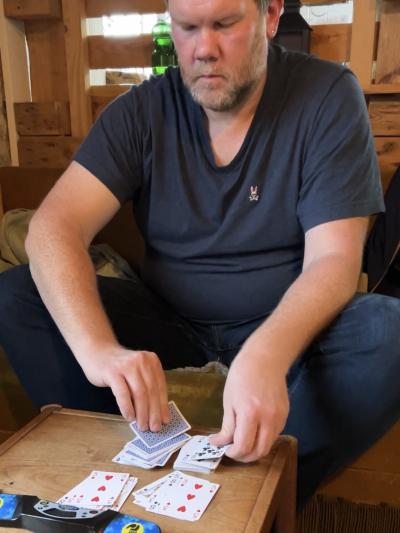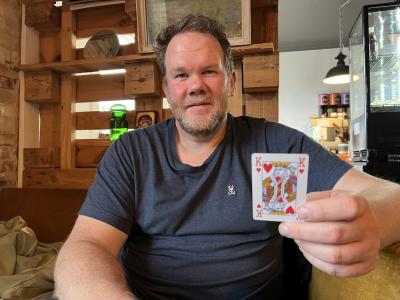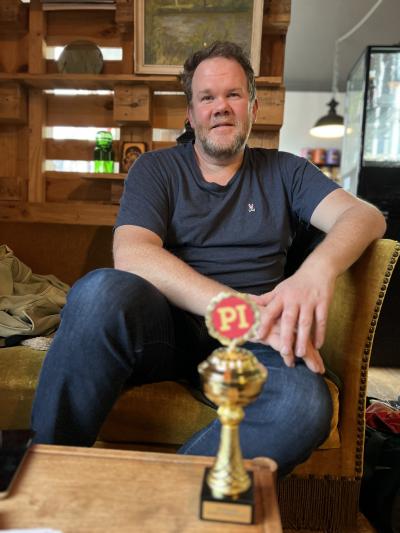Memory-training record-breaker
Danish memory athlete Lars Christiansen has just beaten the world record in the Everest of Memory Tests by recalling the first 10,000 digits of pi. He is able to memorise huge series of digits and entire decks of playing cards. But what actually goes on in a brain as it trains memory on that scale?
Emden, Germany, March 2023:
His face is buried in his hands. Lars Christiansen is seated at an examination table, with a tester and adjudicator opposite him.
‘7-1-4-1-2’ calls the tester in German.
Christiansen responds in seconds:
‘1-1-9-3-0. 2-3-3-9-0.’
The adjudicator next to the tester makes no objections, and the tester continues the prompts.
Danish memory athlete Lars Christiansen is in the process of beating the world record in the Pi Matrix Challenge known as the ‘Everest of Memory Tests’, which involves memorising the first 10,000 digits of pi.
Each time the tester calls out five digits, Christiansen must say the 5-digit sequence that comes before and after that sequence, meaning that he has had to learn 2000 5-digit blocks and also the order in which they occur. For a total of 50 times, he has to remember the digits neighbouring random points in the series of the first 10,000 digits.
Valby, Denmark 2023:
Christiansen started his career as a memory athlete by chance in 2013 while watching TV.
‘I was watching a German talk show where two guests were memorising digits made up of hundreds of 0s and 1s in random order. I was fascinated, wondering ‘How on earth do they do it?’, so I bought a book about memory training and started practising the various techniques,’ he explains.
Christiansen then set about memorising the order of a deck of shuffled playing cards, and whole series of digits, too.
‘You get the knack as you go. It’s like training to sprint 100 metres. You train faster and faster and more and more frequently, until you can go no further. Pushing your limits a bit more each time. That way, you get better and faster all the time,’ he explains.
A little test: We call out the numbers ‘8-4-0-3-1’. He stares into space for a couple of seconds.
‘That’s not part of the 10,000 digits of pi sequence,’ he says. And he’s right.
But how does he know, and how can he answer so fast?
‘I’ve linked a mental image to the first three and last three digits in each block of five. 840 is a horse whisperer tugging at a horse’s legs. 031 is a Mercedes Smart. And there’s no image of a horse and of a Smart side by side in my system, so there’s no 8-4-0-3-1,’ says Christiansen.
In order to memorise the 10,000 digits, Christiansen has 2000 points in his mind, which he sets up along a route, which he can ‘walk’ in his mind so as to meet them in the right order. The thousands of mental images are at fixed waypoints on his long walk, which he can follow as he recalls them.
‘My pi route starts inside the fridge in the place I used to live in Brøndby. From there, I walk over to the cooker, then to the door in the kitchen, the bedroom and once around the house. The station, my doctor in Vallensbæk, past Hvidovre Hospital, past Valby Station and ending at Nørrebro Station in Copenhagen,’ he explains.
Inside a memoriser’s brain
But what is actually going on inside Christiansen’s brain when he memorises these thousands of number blocks? Professor, psychologist and brain researcher Kamilla Miskowiak of the University of Copenhagen explains:
‘Most of the information stored in the human brain is either visual or verbal. Any learning process activates the brain’s frontal lobe, or, more precisely, the dorsolateral prefrontal cortex. Basically, this is the brain’s ‘conductor’, which controls the whole show, and is involved in storing mental images and words in distributed neural networks in the temporal lobes, for example, which are located on the right and left sides of the brain, close to the temples, and in areas of the occipital lobe, at the back of the head,’ Miskowiak explains.

The brain-benefit of using images for memorising numbers is that the information gets stored in both of these neural networks.
‘The verbal information is stored mainly in the left side of the brain, while the visuals are stored in a somewhat overlapping, but mainly right-sided network. And by using memorisation techniques that combine the two sides, our brain stores information in both networks, and that makes accessing the information easier and faster,’ Miskowiak adds.
Memory athletes like Christiansen activate several regions of their brain simultaneously. We know that from brain scan studies of expert chess players, who excel at recalling vast numbers of chess moves and arrangements of chess pieces, the professor explains.
‘Cognitive psychology compares the brain to a computer. Applying that analogy, then Lars is not only using his frontal lobe as a processor, but also his ‘RAM’ in the sense of his working memory, meaning the function that facilitates his ability to bring all the digits to mind and recite them. The frontal lobe is also used for retrieving all the digits from ‘storage’, as in the temporal and occipital networks. The parietal lobe, which is involved in attentiveness, also does its bit, because his excellent recall also requires intense concentration,’ Miskowiak explains.
Trains patients using the same technique
Professor Miskowiak and her research team use the same techniques in psychiatry for training patients with memory problems. Around half of patients who have depression and bipolar disorder have problems with recall and concentration as part of their illness, including in periods when they are otherwise stable.
‘We’re investigating new methods of treating cognitive deficits such as impaired memory because poor recall reduces quality of life and the ability to function in everyday life, including at work. A new study of these patient groups shows that impaired memory is associated with reduced occupational capacity in these patients, and a risk of psychiatric hospital admission,’ says Miskowiak.
Brain scans have also revealed that patients with depression and people with bipolar disorder have problems activating their frontal lobe when they need to learn something new.
‘Conversely, we found that frontal lobe activity was stimulated by cognitive training, and that this was associated with therapeutic benefits,’ says Miskowiak.
She places an illustration on the table. It shows a weeping steak with a red onion in hand next to an equally sad potato-pal in a field of tarragon beneath a sky with an egg yolk, a dab of butter and a slice of lemon as suns, while milk rains down from a cloud.
‘This is a pictorial recipe for a Danish favourite, Béarnaise sauce. We ask the patient to look at the picture for a few minutes and then make up their own little story as an aid to memorising the various ingredients. Next, they have to try and mentally visualise a picture like this with a number of other items on a shopping list,’ Miskowiak explains.
And this drawing is just one example of a simple, but effective tool for brain training.
‘These patients typically struggle with verbal learning processes, so we use their typically intact visual abilities as a way of improving their memory of foods to remember to pick up at the supermarket,’ says Miskowiak.
‘I’m the King of Hearts, James Bond’s the Jack of Clubs’

Christiansen grabs a deck of shuffled cards and spends a minute carefully eyeing them through. He then places a second deck of cards in identical order without looking at the first one. It takes him just under five minutes.
‘All the cards have their own image in my mind. I’m the King of Hearts, James Bond is the Jack of Clubs. The King of Diamonds is a lion, while the Queen of Spades is my friend Anja. So, when I make up the story in my head, I meet James Bond, and a lion wants to eat Anja,’ he explains.
The stories and the routes are pretty easy to follow.
‘The hardest part is learning the techniques required. But once you’ve learnt them, it’s not actually that hard. In the case of pi, I take the trip from Brøndby to Copenhagen. Sure, 2000 waypoints are a lot, and it takes time to get them committed to memory. But once you’ve got your mental images in place, you can learn it in a couple of days and then just practise over and over,’ says Christiansen.
While setting a new record makes him proud, he doesn’t see it as all that remarkable.
‘It’s super easy to learn, but many people think it’s insanely difficult and confuse it with high intelligence. But I’m the type who forgets people’s name, where I left my keys, and what I had for dinner yesterday. And let’s be honest: It’s only a hobby, and the ability to recall 10,000 digits can’t be used for much else. It would probably make more sense to memorise major historical dates,’ says Christiansen with a wry smile.

He is pretty convinced that the training he has done would make him faster than average at learning a new language, for instance. That said, at memorisation championships, he is not convinced everyone present is a genius.
‘I don’t know about brain studies, and although I’m pretty convinced that those memorisers are above average cognitively, it’s the training that makes the difference,’ says Christiansen.
He is considering training for an extended pi discipline where the candidate has to recall numbers while juggling three balls.
‘Just because it sounds fun, and would be a laugh to try,’ he enthuses.
Fun is key
Professor Miskowiak agrees that training accounts for much of Christiansen’s ability, but she says there’s more to it.
‘Training is obviously the most important part, but anyone who learns something demanding, whether they are musicians or scientists, is going to need a lot of willpower and dedication. Having the stamina and single-mindedness does call for intelligence, bearing in mind the thousands of hours that have to be invested in achieving outstanding memorisation feats,’ says the professor.
She also asserts that memory training is definitely worth the effort, whether it’s major historical dates or 10,000 digits of pi.
‘Poor memory has many harmful effects to the point of being disabling, and the strain that comes with that, so cognitive workouts make sense, for healthy individuals as well. Exercise is good, for the brain too, which benefits from being challenged,’ says Miskowiak.
She points to another watchword for memorisation – which is ‘fun’.
‘The fact that Lars is able to learn these techniques is because it’s fun for him. So, if you want to train your brain, it’s a good idea to do so using something you enjoy, like sudoku, crosswords, or 10,000 digits of pi,’ says the professor.
Including while juggling:
‘That’s just another cognitive challenge because it means he has to divide his attention between the digits and the juggling balls. It’s a real feat, but perhaps not that different, brainwise, to singing and playing the piano simultaneously. If you’re juggling, you’re activating a motor skill controlled by the cerebellum, while the frontal lobe, parietal lobe and the neural networks are involved in working memory, attentiveness and number recall. It’s probably a useful, if extraordinary, form of brain training,’ muses Miskowiak.
World record win

Back in Emden in Germany in early March, the tester on the other side of the examination desk calls out the final number:
‘9-5-0-6-8’
Christiansen takes his time. He spends nearly 30 seconds retrieving the two blocks from his mind before answering:
‘8-6-3-6-0. 0-0-6-4-2.’
‘Done!” says the tester, turning with interest to the timekeeper, who notes that at a time of 13 minutes and 38 seconds, Christiansen has lopped 55 seconds off the last world record, and applause is heard from a small crowd in the room.
On breaking the record, Christiansen was taken up with neither the trophy nor the adrenaline rush.
‘I’m a fairly low-key guy, so I went back to my hotel room and watched a soccer match on TV. And as there are no cash prizes in this sport, I had to make do with this here,’ he says, patting the cup with Pi on the emblem.
You didn’t crack open the champagne or down two pints of German lager?
‘No, but next day, when all the contests were over, a group of us went out to eat. And I do believe I had something or other to drink with my meal. But I don’t actually recall what it was, haha.’
- Pi Matrix Challenge record-holder
- Works as a careers counsellor in Copenhagen
- Memorisation technique coach and public speaker
- His next goal is to juggle balls and recall numbers simultaneously
Read more about Lars Christiansen (In Danish)